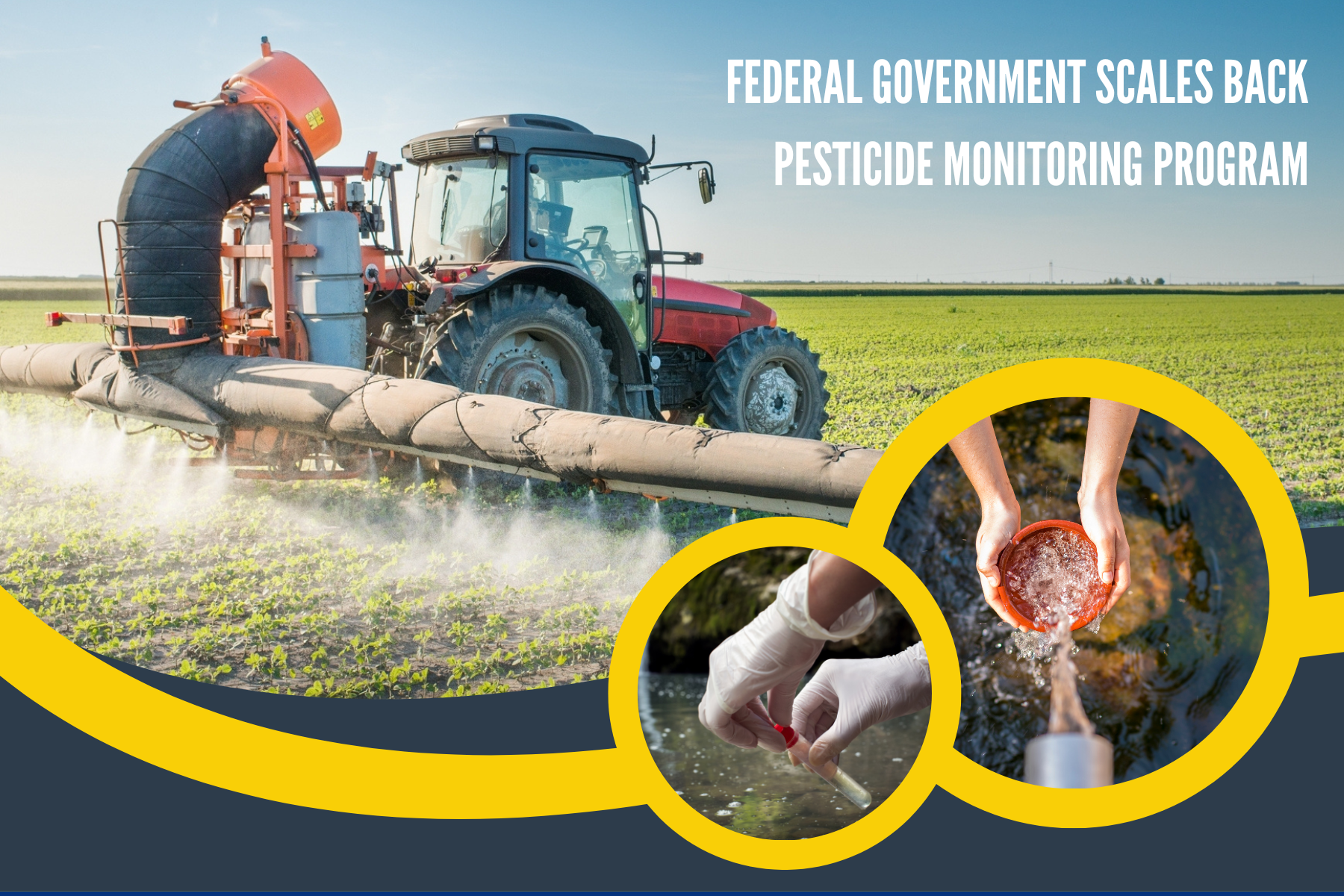
In a big win for the chemical industry and big agriculture, the federal government waters down a program to monitor for pesticides in the Canadian environment
(Ottawa) — Environmental groups are expressing their frustration with the federal government’s plan to scale-back a proposed ambitious pesticide water monitoring program. Earlier this year, the federal government released a proposed water monitoring framework.
Environmental groups say the originally proposed program was to be robust, including citizen monitoring and participation to help Canadians understand how pesticides are contaminating waterways and drinking water sources.
This version of the program was presented to the Scientific Advisory Committee at Health Canada last June. However, after funding was reduced, the federal government has now walked back its ambition.
The proposed framework does not include details for an implementation strategy that outlines the timelines, presentation of the pesticides or frequency of sampling to be required for each pesticide.
After objections from the chemical industry and big agriculture, Health Canada did not include requirements for citizen monitoring in the proposed framework that the federal government has released. The new proposal is relying heavily on existing programs, meaning frequency and methods of samples may be unrelated to pesticide use or predicted impacts — and may fail to shed light on the full extent of pesticide contamination.
The program needs the oversight of experts such as independent academics who do not have conflicts of interest with profit-making from pesticides and their use.
“The national water monitoring program for pesticides must take into account the impacts on high-risk, vulnerable communities, workers and children. These elements must be included, and explicit commitment be made to identify these vulnerable areas for water monitoring,” says Fe de Leon of the Canadian Environmental Law Association. “If the monitoring program is to assess how pesticides are impacting health and the environment, prioritizing monitoring in high risk communities is necessary.”
“Existing monitoring is completely inadequate. Health Canada continues to use information from the United States that is sometimes several decades old to assess the risks of pesticides. Canada does not collect public information on where pesticides are used to identify appropriate monitoring sites. Pesticide companies are not charged fees to cover monitoring costs and are not asked to provide monitoring to support decisions about pesticides,” says Beatrice Olivastri of Friends of the Earth Canada.
“The federal government should follow the polluter pays principle and require chemical companies to pay for robust and independent pesticide monitoring,” says Olivastri. “The lack of sustainable funding to monitor pesticide use and contamination is a ‘don’t ask, don’t tell’ policy that cannot continue.”
“There are over 7000 pesticides registered in Canada and pesticide use has increased by 47 per cent in the last decade. Now is not the time to sit back and scale-back water monitoring plans. We need a clear, transparent and systematic process to better understand pesticide use and contamination in the environment,” says Laura Bowman, a lawyer with Ecojustice
“Despite infrequent and random monitoring, the 2022 pilot program found numerous exceedances of pesticide levels,” she noted.
Recently, Health Canada proposed to re-approve the herbicide atrazine, a product that is banned in Europe but used heavily on corn in Southern Ontario. Atrazine is a suspected endocrine-disruptor with links to breast and prostate cancer, and which was recently linked with Parkinsons and birth defects.
Health Canada models predicted that atrazine could be found in groundwater at 300 times the Canadian Drinking Water Guideline limit, a limit that is already higher than the ones used in Europe and the United States. This prediction cannot be tested without frequent monitoring in targeted locations.
The pilot federal monitoring program in 2022 and other previous water monitoring programs have found that this limit was exceeded in surface water. When more robust sampling has been used, atrazine levels in Southern Ontario were 42 times the drinking water guideline. The groups say more monitoring is needed to protect Canadians.
The groups say that the federal government also had no water monitoring data addressing the predicted serious adverse impacts of atrazine on amphibians in Southern Ontario wetlands including endangered species.
“The proposed framework does not commit to addressing these kinds of serious gaps in assessing pesticide risks to human health and the environment,” says Bowman. “Atrazine is just one example of many showing how the federal government is not taking the risks of pesticide contamination seriously.”
For media interviews and more information, contact:
Zoryana Cherwick, Communications Specialist | Ecojustice
1-800-926-7744 ext. 277, zcherwick@ecojustice.ca
Fe de Leon, MPH, Senior Researcher and Paralegal (deleonf@cela.ca); Theresa McClenaghan, Executive Director and Counsel (theresa@cela.ca), Canadian Environmental Law Association, 416-960-2284 ext. 7210
Beatrice Olivastri, CEO, Friends of the Earth Canada (beatrice@foecanada.org) 613-724-8690
About the organizations:
Canadian Environmental Law Association (CELA) is a legal aid clinic dedicated to environmental equity, justice, and health. Founded in 1970, CELA is one of the oldest advocates for environmental protection in the country. With funding from Legal Aid Ontario (LAO), CELA provides free legal services relating to environmental justice in Ontario, including representing low-income and vulnerable or disadvantaged communities in litigation. CELA also works on environmental legal education and reform initiatives.
Ecojustice uses the power of the law to defend nature, combat climate change, and fight for a healthy environment. Its strategic, public interest lawsuits and advocacy lead to precedent-setting court decisions and law and policy that deliver lasting solutions to Canada’s most urgent environmental problems. As Canada’s largest environmental law charity, Ecojustice operates offices in Vancouver, Calgary, Toronto, Ottawa, and Halifax.
Friends of the Earth Canada is the Canadian member of Friends of the Earth International, the world’s largest grassroots environmental network campaigning on today’s most urgent environmental and social issues in 70 countries.
-30-








